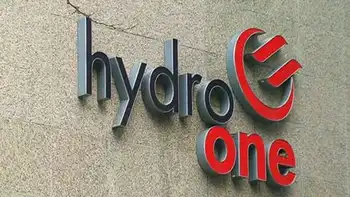Deregulation jolts Texas power bills
This summer, electricity there is some of the nation's priciest.
Power costs are rising in the rest of the U.S., but everything is bigger in Texas: On a hot day in May, wholesale prices rose briefly to more than $4 a kilowatt hour - about 40 times the national average.
"We could end up doubling last year's power prices," says Dan Jones, who monitors the market for the Texas Public Utility Commission to make sure it functions efficiently and is free of manipulation. A Texan shopping for electricity today typically would be quoted a price between 13 and 27 cents a kilowatt hour; the national average is between nine and 10 cents.
Beset by a combination of soaring natural-gas prices for power generators and congested transmission lines that weren't designed to accommodate the new freewheeling market, officials are struggling to figure out what can be done to bring prices back down in a state that consumes more electricity than any other.
"Are my constituents going to be screaming bloody murder in August?" state Rep. Will Hartnett, whose district includes parts of North Dallas, asked at a recent legislative hearing on the electricity market. "I'm worried about what's about to hit us."
Prices in Texas have risen since the industry was freed from regulation, but these recent increases have been quite a shock for America's most audacious experiment in deregulating electric power. Five retail companies that sell electricity to homeowners and small-businesspeople have failed. That has left customers facing unexpectedly high bills when they are quietly and seamlessly switched to other, more-expensive retailers.
Large corporations that buy electricity wholesale from power plants haven't fared any better. A state that once touted its plentiful power sources to energy-intensive industries such as chemical plants and refineries is now seeing "manufacturers look at Georgia and Alabama and see prices that are half what we're paying in Texas," says Tony Bennett, chairman of the Texas Association of Manufacturers.
Still, there is little momentum for big changes. Many Texas officials believe that their system - lots of elbow room and few binding rules - will work out best for consumers in the long run. "The system is working the way it is supposed to work," says state Rep. Phil King, the Republican from Weatherford who is chairman of the House Regulated Industries Committee.
As the nation grapples with the fallout from soaring energy prices, Texas's deregulation roller-coaster offers an example of how a well-intentioned policy can reap unintended consequences. Structuring electricity markets to guarantee both steady supplies and reasonable prices remains one of the biggest challenges for policy makers. Yet deregulation, which has worked with industries as diverse as telecommunications and airlines, hasn't worked as well for electricity.
Some economists argue that power markets pose a special challenge because electricity can't be stored and must be supplied at a moment's notice around the clock, which sometimes gives sellers more leverage than buyers. When California tried to deregulate its electricity market, it stumbled into an energy crisis that bankrupted its biggest utility.
Not long ago, Texas thought it had the answer. When then-Gov. George W. Bush signed the state's deregulation bill in 1999, he assured that "competition in the electric industry will benefit Texans by reducing monthly rates and offering consumers more choices." The law, which took effect in 2002, left few restrictions on what power generators could charge and what consumers could pay.
The utility commission gradually relinquished the authority to set electricity prices in about 75% of the state - those areas not covered by municipal power departments, rural cooperatives or investor-owned companies that were better connected with neighboring states. Competition would govern them.
As part of the plan, utilities couldn't continue to operate as a vertically integrated whole, generating, transmitting and selling power to captive customers. Divisions were spun off or organized into operating units of holding companies.
The specter of having competitors for the first time spurred power-plant owners to modernize. The newest plants are about a third more efficient than the ones they are replacing. What didn't change much is the mix of fuels used to make electricity: Gas still accounts for about half of the state's power generation, compared with about 20% for the U.S. as a whole.
That seemed like a good idea as Texas has plenty of gas and it burns more cleanly than coal. But gas prices are about five times the level they were in 2002, and about twice what they were a year ago. When natural gas rises, the bounce is felt instantly in power prices across the state because wholesale electricity prices are pegged to natural-gas costs. Even power generated from nuclear fission, wind or coal is priced as if it were coming from natural gas because of its dominant position in the Texas marketplace.
Another part of the deregulation plan was encouraging the creation of a slew of retailers that would buy power wholesale from generators and then sell it to businesses and homes. To promote choice, the state intentionally set low requirements, allowing retailers to open up shop with as little $100,000 in capital.
The state soon had nearly 100 retailers, giving Texans more choices than consumers anywhere else in the U.S. - from plans that offered fixed prices to ones that fluctuated with the market. Some retailers tried to lure customers with gimmicks like free golf balls; others offered clean energy from wind turbines.
Bob Zlotnik, co-founder of StarTex Power, had a previous career as a promoter of tractor pulls and rock concerts. He says people came to the business from all walks of life, and not all were prepared. "I'm not sure people know how to assess all the risks" of a deregulated market, says Mr. Zlotnik, whose wife and partner has experience in deregulated power and telecommunications. It's hard for the public to know just how savvy a retailer is.
Things become especially hairy when retailers have to buy electricity on the state's daily spot market - a daily exchange where power is bought and sold. Most retailers try to sign long-term deals with generators to get the power they need. But at times, demand jumps, and retailers need to buy extra power on the spot market.
Larry Kelly, chief operating officer for retailer Texas Power L.P., says that spot-market prices have spiked so much that he raised his prices to between 18 cents and 22 cents a kilowatt hour for electricity, up from about 12 cents last year.
Some retailers report they've had difficulty finding suppliers willing to sign long-term deals to sell them power, raising suspicions that generating companies may be intentionally forcing retailers to get supplies through the expensive daily auction. Generating companies deny this, and Mr. Jones, the utility commission's market monitor, says he's looking into the matter.
Already, high spot-market prices have pushed five electricity retailers, serving about 45,000 customers, into default. More defaults are possible because many retailers are small companies working on thin margins. When retailers go under, customers' lights stay on as their accounts are switched automatically to "providers of last resort" - nearly always with higher rates. Many customers don't find out about it until their next bill.
John Dreese, an aeronautical engineer in Fort Worth, heard his power supplier, National Power Co., had gone bust in May and began shopping for a replacement. Before he could ink a deal, he was automatically switched to TXU Energy, a unit of Energy Future Holdings Corp. of Dallas, formerly TXU Corp. His price jumped 71% overnight, to 18.8 cents a kilowatt hour from 11 cents.
"No way was I going to pay that," says Mr. Dreese. He was able to shop the market and switch to another retailer for 13.3 cents a kilowatt hour.
Mr. Dreese says he lived in California during its energy crisis and has a sense of déjà vu. "I don't think the promise of deregulation can ever be reached," he says. "You just add a lot of middlemen."
Like homeowners unaware of the risks of an adjustable-rate mortgage, some consumers didn't realize how wildly their bills could vary if they chose plans tied to the market. Steve Schwantes, a Round Rock resident who was laid off last winter from his job as a finance manager at Dell Inc., just got his June utility bill and expected it to be similar to his May bill for $189. Instead, it was $488.
"I was completely shocked," he says. His electricity provider raised its prices twice in a single billing cycle, jacking up his cost by 47% to 18.7 cents a kilowatt hour. Hot weather meant he used more electricity to cool his two-story home. He's now closing off part of the house and has found a cheaper plan.
Large customers aren't immune to making bad bets in the deregulated marketplace. Alcoa Inc. got into trouble at its Rockdale aluminum smelter when a nearby power plant it had been relying on began breaking down. The provider, Luminant, a unit of Energy Future Holdings, offered power from other sources but at 16 cents a kilowatt hour instead of the 3.8 cents that Alcoa had been paying. Alcoa opted to take a chance and buy power off the spot market, instead.
It was the wrong move. It sometimes had to pay $2 to $4 a kilowatt hour for electricity. "There are days we've lost millions of dollars," says Alcoa spokesman Kevin Lowery in Pittsburgh. It estimates the toll from lower output and higher costs will top $44 million. "You can't run a business that way," Mr. Lowery says.
The company recently announced that it was cutting 250 of its 900 workers and halving its output in Rockdale.
Luminant says it tried to help Alcoa, but "we told them we couldn't offer a below-market price," says Lisa Singleton, company spokeswoman.
Texas intentionally designed its system to allow for wide price swings. State officials believe that occasional spikes entice companies to build more power plants and transmission lines. Next year, the maximum price generators will be able to seek in the spot market will jump to $3,000 a megawatt hour, or $3 a kilowatt hour, from the current $2,250, or $2.25 per kilowatt hour. Most other deregulated markets in the U.S. have a maximum price of $1,000.
But one of the problems plaguing Texas is that it is still using an electricity grid that was designed to support the old regional power giants, not a dynamic statewide market.
Often, the cheapest power to produce - say, from wind farms in West Texas - can't reach the buyers that might need it most, such as office buildings in Houston. That's because the grid - like a poorly designed freeway - doesn't have enough capacity to move power easily around the state.
Each day, the Electric Reliability Council of Texas, or Ercot - created by the state to operate the grid and the daily power auctions - runs congestion-management software that helps it figure out which plants' electricity to buy. It pays extra money to some plants to run more than they'd proposed, and it pays others to run less.
For reasons that are still not well understood, the mismatch has worsened this summer. The incidence of congestion jumped 270% this May over May 2007. As a result, spot-market prices, at times, have gotten as high as $4,000 a megawatt hour, actually exceeding the price cap of $2,250 a megawatt hour because of the incentive payments.
Mr. Jones, the market monitor, says Ercot has tweaked its software to do a better job holding down prices.
Some power companies have found ways to make a bundle off congestion.
Suez Energy Marketing NA, a division of Paris-based Suez SA, owns a tiny 70-megawatt plant near Houston. On days of high demand, Suez says it offers 60 megawatts at $170 a megawatt hour, a price low enough to guarantee Ercot will ask it to run. Then it offers the final 10 megawatts at the maximum price allowed, $2,250 a megawatt hour.
In Texas's deregulated market, that means if Suez can sell more than 60 megawatts, it can charge the $2,250 rate not just for the last 10 megawatts, but for all the power from the plant.
At that rate, Suez collects $157,500 an hour to run the plant, versus the $12,000 an hour it would get if it priced everything at $170 a megawatt hour.
John Henderson, senior vice president of generation for Suez, says the plant can make a decent return if it garners that $2,250 price at least 15 hours a year. "In this business," explains Mr. Henderson, "you have feast years and you have famine years." He acknowledges that 2008 is shaping up to be a feast year.
The practice is reminiscent of one that played a role in the meltdown of California's electricity market earlier this decade. Afterwards, the Federal Energy Regulatory Commission prohibited "hockey-stick bidding," named because a graph of the bid structure makes it look like a hockey stick standing on its blade. The deregulated Texas market, because it has no major connection to other states' grids, is not subject to FERC rules.
Suez spokesman Rob Minter says his firm doesn't practice hockey-stick bidding but uses a rational strategy to operate the plant profitably under the law.
Texas plans to make improvements to its electricity market which officials say will help ease the recent transmission congestion and, hopefully, bring prices down. Early next year, Ercot plans to roll out a new $325 million computer system that will change the way it handles congestion. California has been working on a similar system for seven years and is still not done.
The grid operator also will add a new energy auction for power intended to be delivered the next day instead of on the current day like the spot market, something it hopes will bring more orderliness to the market.
State officials say Texas has gone too far to turn back now. "I don't think we can put the toothpaste back in the tube," says Mr. King, the state representative. "All we can do is go forward."
Related News

Iran turning thermal power plants to combined cycle to save energy
TEHRAN - Iran has turned six percent of its thermal power plans into combined cycle plants in order to reduce greenhouse gases and save energy, IRNA reported, quoting an energy official.
According to the MAPNA Group’s Managing Director Abbas Aliabadi, so far 27 thermal power plants have been converted to combined-cycle ones.
“The conversion of a thermal power plant to a combined cycle one takes about one to two years, however, it is possible for us to convert all the country’s thermal power plants into combined cycle plants over a five-year period.
Currently, a total of 478 thermal power plants are operating throughout…





